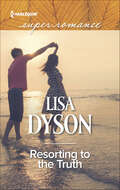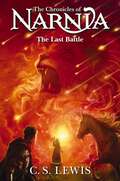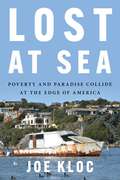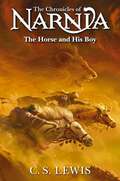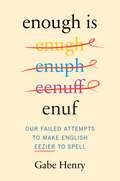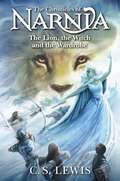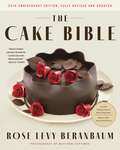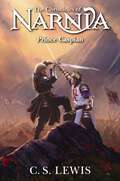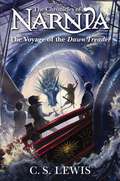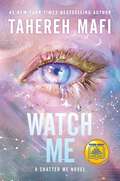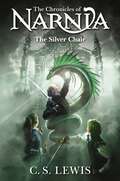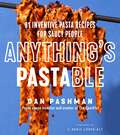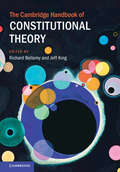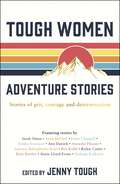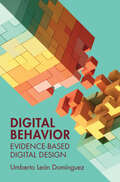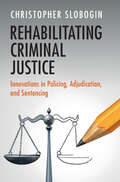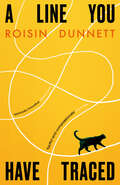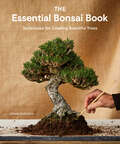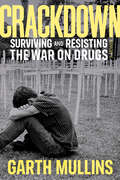- Table View
- List View
Environmental Toxicants: Human Exposures and Their Health Effects
by Morton Lippmann George D. LeikaufAn Updated Reference on Human Exposure to Environmental Toxicants and A Study of Their Impact on Public Health With the 4th edition of Environmental Toxicants: Human Exposures and Their Health Effects, readers have access to up-to-date information on the study and science of environmental toxicology and public health worldwide. Practitioners and professionals can use this resource to understand newly discovered information on the adverse health effects of toxins and pollutants in air, water, and occupational and environmental environments on large human populations. The 4th edition of this book is updated to reflect new knowledge and research on: ● Performing risk assessments on exposed individuals ● Assessing the effects of toxicants and substances on large populations for health and medical professionals ● Patterns of human exposure to select chemical toxicants ● World Trade Center dust, agents for chemical terrorism, and nanoparticles For health professionals, including health authorities, public health officials, physicians, and industrial managers, who are seeking new research and techniques for managing environmental substances, this invaluable reference will guide you through in a thorough, easy- to-read manner.
Resorting to the Truth
by Lisa DysonIn love we trust... She may have found the twin sister she never knew she had...but Charlotte Harrington also lost her mother. And now she's lost her artistic inspiration, too. Escaping to a lush tropical resort is her best shot at getting something of her own back again. She just needs to focus and somehow not let Sam Briton's guarded smile distract her. Managing a hotel and single fatherhood puts plenty on Sam's plate, Charlotte gets that. And the suspicion in his deep blue eyes can only lead to big-time trouble for a woman who struggles with the truth. So why is she driven by the need to convince him that love is worth opening his heart?
The Magician's Nephew (Chronicles of Narnia #1)
by C. S. LewisDon’t miss one of America’s top 100 most-loved novels, selected by PBS’s The Great American Read. Narnia . . . a land frozen in eternal winter . . . a country waiting to be set freeWitness the creation of a magical land in The Magician's Nephew, the first title in C. S. Lewis's classic fantasy series, which has captivated readers of all ages for over sixty years On a daring quest to save a life, two friends are hurled into another world, where an evil sorceress seeks to enslave them. But then the lion Aslan's song weaves itself into the fabric of a new land, a land that will be known as Narnia. And in Narnia, all things are possible.This ebook contains the complete text and art. Illustrations in this ebook appear in vibrant full color on a full-color ebook device and in rich black-and-white on all other devices.This is a stand-alone novel, but if you want to journey back to Narnia, read The Lion, the Witch and the Wardrobe, the second book in The Chronicles of Narnia.
The Last Battle: The Chronicles of Narnia (Chronicles of Narnia #7)
by C. S. LewisIllustrations in this ebook appear in vibrant full color on a full-color ebook device and in rich black and white on all other devices.Narnia . . . where lies breed fear . . . where loyalty is tested . . . where all hope seems lost.During the last days of Narnia, the land faces its fiercest challenge—not an invader from without but an enemy from within. Lies and treachery have taken root, and only the king and a small band of loyal followers can prevent the destruction of all they hold dear in this, the magnificent ending to The Chronicles of Narnia.The Last Battle is the seventh and final book in C. S. Lewis’s The Chronicles of Narnia, a series that has become part of the canon of classic literature, drawing readers of all ages into a magical land with unforgettable characters for over sixty years. A complete stand-alone read, but if you want to relive the adventures and find out how it began, pick up The Magician’s Nephew, the first book in The Chronicles of Narnia.
Lost at Sea: Poverty and Paradise Collide at the Edge of America
by Joe KlocA deeply personal nine-year account of the lives of the “anchor-outs”—an unhoused community living off the California coast on abandoned boats—that explores the struggles and resilience of those surviving on the fringes of society.In the wake of the financial crisis, the number of anchor-outs living in Richardson Bay more than doubles as their long-simmering feud with the wealthy residents of Marin County—one of the richest counties in the country—finally boils over. Many of the shoreline’s well-heeled yacht club members and mansion owners blame their unhoused neighbors for rising crime on the waterfront. Meanwhile, local politicians accuse them of destroying the Bay Area’s marine ecosystem and demand their eviction. When the pandemic breaks out, a slew of city and regional authorities heed the call: they seize and crush the anchor-outs’ boats, arresting dissenters as they dismantle one of the nation’s oldest unhoused communities.Kloc’s near-decade-long firsthand account of the joys, hardships, and eventual demise of the anchor-outs is in many ways the story of being poor in America. Examining the profit-driven policies that exacerbate the contemporary housing crisis, Lost at Sea weaves together tales of comradery and survival on the anchorage with the rich history of the region, from the creation of unspeakable wealth during the San Francisco Gold Rush era to the aftermath of the devastating earthquake and fire of 1906, when the first unhoused people dropped their anchors in Marin County.Along the way, Kloc discovers the quiet beauty of the world the anchor-outs built: how they’ve learned to care for each other, band together to fend off real estate developers and NIMBY neighbors, and fight for a way of life that is entirely unrecognizable to those on shore. Lost at Sea explores the often overlooked world of poverty and homelessness that exists in even the wealthiest enclaves of America, where people who have fallen on hard times struggle to rebuild their lives among those who would rather just wish them away.
The Horse and His Boy: The Chronicles of Narnia (Chronicles of Narnia #3)
by C. S. LewisIllustrations in this ebook appear in vibrant full color on a full-color ebook device and in rich black and white on all other devices.Narnia . . . where horses talk . . . where treachery is brewing . . . where destiny awaits.On a desperate journey, two runaways meet and join forces. Though they are only looking to escape their harsh and narrow lives, they soon find themselves at the center of a terrible battle. It is a battle that will decide their fate and the fate of Narnia itself.The Horse and His Boy is the third book in C. S. Lewis's The Chronicles of Narnia, a series that has become part of the canon of classic literature, drawing readers of all ages into a magical land with unforgettable characters for over sixty years. This is a novel that stands on its own, but if you would like to return to Narnia, read Prince Caspian, the fourth book in The Chronicles of Narnia.
Enough Is Enuf: Our Failed Attempts to Make English Easier to Spell
by Gabe HenryA brief and humorous 500-year history of the Simplified Spelling Movement from advocates like Ben Franklin, C. S. Lewis, and Mark Twain to texts and Twitter.Why does the G in George sound different from the G in gorge? Why does C begin both case and cease? And why is it funny when a philologist faints, but not polight to laf about it? Anyone who has ever had the misfortune to write in English has, at one time or another, struggled with its spelling.So why do we continue to use it? If our system of writing words is so tragically inconsistent, why haven’t we standardized it, phoneticized it, brought it into line? How many brave linguists have ever had the courage to state, in a declaration of phonetic revolt: “Enough is enuf”? The answer: many. In the comic annals of linguistic history, legions of rebel wordsmiths have died on the hill of spelling reform, risking their reputations to bring English into the realm of the rational. This book is about them: Mark Twain, Ben Franklin, Eliza Burnz, C. S. Lewis, George Bernard Shaw, Charles Darwin, and the innumerable others on both sides of the Atlantic who, for a time in their life, became fanatically occupied with writing thru instead of through, tho for though, laf for laugh, beleev for believe, and dawter for daughter (and tried futilely to get everyone around them to do it too). Henry takes his humorous and informative chronicle right up to today as the language seems to naturally be simplifying to fit the needs of our changing world thanks to technology—from texting to Twitter and emojis, the Simplified Spelling Movement may finally be having its day.
Celebrating Every Day: 100 Easy Recipes to Make Any Day Feel Special
by Melissa JohnsonTurn every day into a special celebration with 100 easy, super-fun, memorable recipes for meals, treats, and sweets, from Melissa Johnson, of the massively popular blog Best Friends for Frosting.Celebrating shouldn’t be limited to just holidays and birthdays—you can make any day special for your loved ones, even a regular old school day, especially with Melissa Johnson, the creator behind Best Friends for Frosting, by your side. Instead of spending hours in the kitchen, Melissa loves to sit down and enjoy a meal with her family and loved ones—so her recipes are super achievable and affordable, making them easy on tired parents, inviting to picky kids, and all around a joy to put on the table.Perfect for tradition keepers and memory makers, Celebrating Every Day shares tried-and-true classics and festive holiday treats with 100 affordable and no-fuss recipes that serve as instant mood-boosters, with chapters covering:Easy BreakfastFamily-Friendly DinnersAppetizers for CelebrationsWalking TreatsTime-Saving Dessert ShortcutsFruity TreatsCelebrate with ChocolateHoliday Cheer All YearMake Melissa’s Viral Million Dollar Spaghetti with just 5 ingredients, or have breakfast on the table easy, with her Muffin Tin Pancakes. You’ll find icons bookmarking recipes perfect for actual holidays, too, like 3-Ingredient Crescent Mummy Dogs for Halloween or Frosty Snowman Donut Skewers for winter holidays. This bright and cheerful cookbook is for more than just getting dinner on the table for a hungry family—it’s for creating lasting memories, bringing loved ones together, starting family traditions, and making the ordinary extraordinary.
The Lion, the Witch and the Wardrobe (Chronicles of Narnia #2)
by C. S. LewisThe Lion, the Witch and the Wardrobe is the second book in C. S. Lewis's The Chronicles of Narnia, a series that has become part of the canon of classic literature, drawing readers of all ages into a magical land with unforgettable characters for over fifty years. Four adventurers step through a wardrobe door and into the land of Narnia, a land enslaved by the power of the White Witch. But when almost all hope is lost, the return of the Great Lion, Aslan, signals a great change . . . and a great sacrifice. This ebook contains the complete text and art. Illustrations in this ebook appear in vibrant full color on a full-color ebook device and in rich black-and-white on all other devices. This is a stand-alone read, but if you would like to explore more of the Narnian realm, pick up The Horse and His Boy, the third book in The Chronicles of Narnia.
The Cake Bible, 35th Anniversary Edition
by Rose Levy BeranbaumThe legendary IACP Culinary Classic The Cake Bible—found in the kitchen of every serious baker and beloved for decades—with classic recipes thoroughly updated and including about 30% new recipes and methods and the latest ingredient and equipment informationThe original Cake Bible is a guiding light in the world’s baking literature, with Rose Levy Beranbaum’s deep knowledge and respect for craft to be found on every page. It’s for home and professional bakers who want to make glorious, technically perfect cakes and understand why the ingredients in cakes work the way they do.The book was hugely influential from the moment it first came out in 1988, selling hundreds of thousands of copies and going through sixty printings. It introduced the reverse creaming method, incorporating flour and butter first instead of butter and sugar. This makes mixing faster and easier, helps cakes rise more evenly, and results in a finer and more tender cake texture. And it’s among the first United States cookbooks to offer measurements in weights, highlighting the superiority of the metric system, which has become the gold standard in baking books.But a lot has changed in thirty-five years—and The Cake Bible has changed with it! This striking new edition—with new photographs in an expanded section--contains recipes for classic and innovative cakes and complementary adornments of all types, instructions for making stunning decorations, and flavor variations for every craving and occasion, with foundational recipes like All-Occasion Downy Yellow Butter Cake and Angel Food Cake and showstoppers like the Strawberry Maria, which brings together Génoise au Chocolat, Grand Marnier-flavored syrup, and Strawberry Cloud Cream. Rose also provides instructions for baking for special occasions, such as weddings, with recipes to serve 150 people as well as formulas to scale the recipes for any number of desired servings.For thirty-five years, Rose has been tweaking and reworking her methods based on reader feedback and constant conversations with other bakers and food and equipment professionals. Rose’s fans, professional and amateur alike, will love this perfect distillation of her decades of experience and the pure joy of creation.
Prince Caspian: The Return to Narnia (Chronicles of Narnia #4)
by C. S. LewisIllustrations in this ebook appear in vibrant full color on a full-color ebook device and in rich black and white on all other devices.Narnia . . . where animals talk . . . where trees walk . . . where a battle is about to begin.A prince denied his rightful throne gathers an army in a desperate attempt to rid his land of a false king. But in the end, it is a battle of honor between two men alone that will decide the fate of an entire world.Prince Caspian is the fourth book in C. S. Lewis’s The Chronicles of Narnia, a series that has become part of the canon of classic literature, drawing readers of all ages into a magical land with unforgettable characters for over sixty years. This is a stand-alone novel, but if you would like to see more of Lucy and Edmund’s adventures, read The Voyage of the Dawn Treader, the fifth book in The Chronicles of Narnia.
The Voyage of the Dawn Treader: The Chronicles of Narnia (Chronicles of Narnia #5)
by C. S. LewisIllustrations in this ebook appear in vibrant full color on a full-color ebook device and in rich black and white on all other devices.Narnia . . . where a dragon awakens . . . where stars walk the earth . . . where anything can happen.A king and some unexpected companions embark on a voyage that will take them beyond all known lands. As they sail farther and farther from charted waters, they discover that their quest is more than they imagined and that the world's end is only the beginning.The Voyage of the Dawn Treader is the fifth book in C. S. Lewis’s The Chronicles of Narnia, a series that has become part of the canon of classic literature, drawing readers of all ages into a magical land with unforgettable characters for over sixty years. This is a novel that stands on its own, but if you would like to continue to the journey, read The Silver Chair, the sixth book in The Chronicles of Narnia.
Watch Me (The Shatter Me Series: The New Republic #1)
by Tahereh MafiLose yourself in this exhilarating return to the #1 global bestselling Shatter Me universe, the first book in a new series set ten years after the fall of The Reestablishment.James Anderson had a plan. Or half of one. He managed to do what his older brother, the famous Aaron Warner Anderson, never did: infiltrate Ark Island, the last refuge of The Reestablishment. No outsider has breached the stronghold of the authoritarian regime, but James is in. In a prison cell, sure, but as far as James is concerned, a win is a win.It’s been ten years since the notorious duo Juliette Ferrars and Aaron Warner Anderson led a worldwide rebellion and established the New Republic of the West. But The Reestablishment is ready to make a devastating move, and they have the perfect assassin for the job.Rosabelle Wolff had a plan. She always has a plan. On Ark Island, where constant surveillance is packaged as security, even emotions must be experienced with caution. Her every movement is monitored—and when she’s given an order to kill, she never hesitates.Brimming with pulse-pounding action and torturous romance, Watch Me is an explosive journey through a dystopian landscape where enemies-to-lovers has never felt more impossible. Step into a beloved and breathtaking world that demands an answer to a desperate question—Who are we when no one is watching?
The Silver Chair: The Chronicles of Narnia (Chronicles of Narnia #6)
by C. S. LewisIllustrations in this ebook appear in vibrant full color on a full-color ebook device and in rich black and white on all other devices.Narnia . . . where giants wreak havoc . . . where evil weaves a spell . . . where enchantment rules.Through dangers untold and caverns deep and dark, a noble band of friends is sent to rescue a prince held captive. But their mission to Underland brings them face-to-face with an evil more beautiful and more deadly than they ever expected.The Silver Chair is the sixth book in C. S. Lewis’s The Chronicles of Narnia, a series that has become part of the canon of classic literature, drawing readers of all ages into a magical land with unforgettable characters for over sixty years. This is a complete stand-alone read, but if you want to discover what happens in the final days of Narnia, read The Last Battle, the seventh and concluding book in The Chronicles of Narnia.
Anything's Pastable: 81 Inventive Pasta Recipes for Saucy People
by Dan PashmanA BEST COOKBOOK OF THE YEAR: Wired, Food & Wine, Epicurious, & EsquireWinner, 2025 Libby Award for Best Cookbook of the YearThe innovative James Beard Award–winning podcaster who changed the way you think about pasta shapes with his invention of the viral sensation cascatelli now does the same for pasta sauces in this fun and charmingly obsessive cookbook, which includes a foreword from bestselling author J. Kenji López-Alt.When Sporkful podcast host Dan Pashman launched cascatelli, a new pasta shape he invented that he designed to hold tons of sauce, stay on the fork, and be incredibly satisfying to bite into, it went viral and was named one of TIME Magazine’s Best Inventions of the Year. VICE called him "a modern pasta legend."But as Dan was flooded with pictures of what people were making with his pasta, he was disappointed to see how limited the dishes were: tomato sauce, meat sauce, mac and cheese, over and over. A few party animals made pesto.So Dan set out to revolutionize people’s conceptions of pasta sauces, just as he did with pasta shapes. He traveled across Italy and worked with an all-star team of recipe developers in the US to create a new kind of pasta sauce cookbook for people bored with the old standbys. That’s why there’s no 3-hour marinara recipe or fresh pasta made from scratch in this book. No photos of nonnas caked in flour or the hills of Tuscany. Instead it’s time to show the world—Anything’s Pastable.Here you’ll enjoy dishes inspired by a range of ingredients and cuisines:Kimchi CarbonaraCacio e Pepe e Chili CrispKeema BologneseMapo Tofu CascatelliShakshuka and ShellsSmoked Cheddar and Chicken Manicotti “Enchiladas”Linguine with Miso Clam SauceShrimp and Andouille Mac and CheeseLesser-known Italian pasta dishes with a twist:Spaghetti all’Assassina (spicy pasta pan fried until charred and crispy crunchy)Ciceri e Tria (chewy fresh pasta with crispy fried pasta in a light chickpea broth)Cavatelli with Roasted Artichokes and Preserved LemonCreste di Gallo with Fava Beans and Dandelion GreensPasta FrittataFun and delicious concoctions that may—or may not—be how they do it in Italy:Spinach Artichoke Dip Lasagna PinwheelsPasta Pizza (the “crust” is fettucine fused together)Roman Cafeteria Hot Dog Pasta Salad with Canned VeggiesWith an incredible array of recipes, Dan showcases the limitless pastabilities when you really know how to use your noodle.
The Cambridge Handbook of Constitutional Theory (Cambridge Law Handbooks)
by Richard Bellamy Jeff KingThis Handbook brings together contributions from leading scholars of constitutional theory, with backgrounds in law, philosophy and political science. Its sixty chapters not only offer an exceptional survey of the field but also provide a major contribution to it. The book explores three main areas. First, the values upheld by a constitution, including rights, freedom, equality, dignity and well-being. Second, the modalities of a constitutional system, such as the separation of powers, democratic representation and the rule of law. Finally, the institutions through which it operates, both legal and political, including courts, elections, parliaments and international organisations. It also considers the challenges confronting constitutional arrangements from growing inequality, populism, climate change and migration.
Tough Women Adventure Stories: Stories of Grit, Courage and Determination
by Jenny ToughThe badass adventurers in this collection are all fearless, intelligent, compassionate and curious about the world – and they all happen to be female. From arctic expeditions and endurance races to wingsuit flying and mountain climbing, they have set the bar high for what women are capable of. These are their inspiring stories.
Riding Out: A Journey of Love, Loss and New Beginnings
by Simon Parker"A truly inspiring journey that celebrates the healing power of adventure. A must-read." - Levison WoodThe remarkable and inspirational true story of how one man battled grief and anxiety, one pedal stroke at a time, on a 3,500-mile adventure around BritainIn March 2020, as Britain entered its first lockdown, Simon Parker's life fell apart; his travel journalism career vanished overnight and shortly afterwards he received the tragic news that a close friend had died. With a long-suppressed anxiety disorder starting to rear its head, he turned to the only therapies he knew and trusted: travel and exercise.Setting off on his bike from the northernmost point of Shetland with only a sleeping bag and a camping stove, Simon would end up cycling 3,427 miles around Britain. En route, he would meet hundreds of resilient Britons, who were all, in their own way, riding out the storm just like he was. Even in his gloomiest moments he began to see that a chink of light was never too far away.Riding Out is a story of optimism and hope, and a ground-level portrait of Britain as it transforms from a country in crisis to a nation on the mend. From Shetland to the Scillies, Dover to Durness, Simon learns that life's sharpest corners are best navigated at the gentle pace of a bicycle.
Digital Behavior: Evidence-Based Digital Design
by Umberto Leon DominguezIn a technologically advanced and competitive landscape dominated by major tech companies and burgeoning start-ups, the key asset lies in boosting monthly active users. Traditionally, product design has relied on fragmented insights from personal experience, common sense, or isolated experiments. This work endeavours to establish a theoretical framework for predicting and influencing the digital behaviour of technology users. Drawing on over a century of scientific research in behaviour, cognition, and physiology, this presents a comprehensive approach to customizing digital stimuli. The objective is to enhance user interactions with digital and virtual environments. Through real and cost-effective examples, diagrams, and formulas, the text offers theoretical knowledge and a practical methodology to elevate digital product designs, setting them apart from the competition. With the potential to reshape the digital design landscape, this book emerges as a game-changer, promising to revolutionize how digital products and services are conceived and delivered.
Rehabilitating Criminal Justice: Innovations in Policing, Adjudication, and Sentencing
by Christopher SloboginRehabilitating Criminal Justice offers bold yet sensible proposals for reforming every major component of the US criminal justice system. The first third of the book explains how existing caselaw can be interpreted to end over-policing, better regulate interrogations, and replace the exclusionary rule with direct sanctions on officers and their departments. The second part of the book, on the post-arrest adjudication process, calls for replacing cash bail with validated risk assessments and proposes to reorient our error-prone, hyper-adversarial system by ending convictions via guilty pleas and giving judges more power over questioning of witnesses and the selection of experts. The final chapters show how the harshness of the system can be leavened by refocusing sentencing on prevention rather than retribution and by creating an independent criminal court system. They also explain why these reforms are preferable to the currently popular movement to defund police departments and abolish prisons.
How to Decarbonize: Policy and Social Theory
by Ross AstoriaHow to Decarbonize explores opportunities for decarbonization introduced by recent federal legislation, which has prompted state-level climate planning. It is designed for students and professionals whose work brings them into contact with these opportunities, even if climate is not their primary profession, including city managers, bankers, and home builders who are interested in participating in planning for decarbonization. Chapters aim to support the successful uptake of these policies by providing high-level views of these new decarbonization policies using social theory. The book is divided into four sections, each introducing a social theory about the organization of societies and how they change, and then providing examples to demonstrate the intricacies of implementation.
Amoya Blackwood Is Brave
by Chantaie AllickWhen a girl's confidence is shaken and she begins to shrink, her grandmother is there to remind her of who she is in this empowering picture book about self-esteem.Amoya Blackwood is loud, bold and carefree. She always has the answer in class. And she knows just what to say to make her friends laugh.Amoya Blackwood shows up with a smile on her face. She enters a room and takes up space.But one day Amoya Blackwood starts noticing that the adults around her want to be less loud, less bold, less carefree. They want her to take up less space, and so she does. She gets smaller and smaller and smaller.She gets so small she hardly recognizes herself.But then, a conversation with her Gran reminds Amoya of who she is. And a surprising thing happens . . .
A Line You Have Traced: A novel
by Roisin DunnettNamed one of the 'Best New Science Fiction Books of April 2025' by New Scientist Cloud Atlas meets This Is How You Lose the Time War in this gorgeous speculative novel that explores how a mysterious red journal connects three women born centuries apart in East London.In the Jewish East End of post-World War I London, Bea, a young shopkeeper's wife, is visited by an uncanny figure she believes is an angel. She tries to understand the meaning of these visits as the life she is building with her new husband is threatened by fascists who are increasingly targeting her friends and neighbors. Kay spends nights partying with her friends in contemporary East London's underground queer scene, where one of them is gaining fame as a drag queen. She entertains herself by imagining that people she passes on the street are time travelers who have come back in time specifically to visit her. As she becomes infatuated with the brilliant O, she discovers an aged red notebook that seems to be the journal of an ancestor who was also visited by a mystical being. One hundred years in the future, against a backdrop of climate emergency and violent oppression, Ess lives off the grid as part of a collective that's planning for the end of human life on earth. After uncovering an ancient worn red book in an archive, she is invited to a nearby commune to help with a critical mission: a journey into the past to possibly help save the present. Epic in scope, with unforgettable characters and a rare clarity of vision, A Line You Have Traced asks profound questions about how we might survive and engage with the world, and with each other, before it&’s too late.
The Essential Bonsai Book: Techniques for Creating Beautiful Trees
by Jonas DupuichA beautifully photographed, in-depth guide to the fundamental techniques used to create exquisite bonsai, from the author of The Little Book of Bonsai and the Bonsai Tonight blog. &“Anyone working and living with these little trees will find essential guidance for making beautiful bonsai!&”—Tyler Sherrod, bonsai artist and teacherIn The Essential Bonsai Book, trusted educator Jonas Dupuich provides a framework for building a bonsai collection you can take pride in. This accessible guide teaches you fundamental bonsai techniques such as pruning, wiring, and repotting, as well as more advanced skills like decandling and defoliating. Learn how to work with the seasons and discover design tips and tricks for bringing out the beauty in your trees. Featuring case studies demonstrating how to use the various techniques, and insights from other bonsai experts, The Essential Bonsai Book will help you grow beautiful bonsai in your own home or garden.
Crackdown: Surviving and Resisting the War on Drugs
by Garth MullinsPart memoir, part manifesto, Crackdown is a story of the drug war, told from the frontlines.Garth Mullins was born into a world too bright for him to fully see, and too unforgiving to fully accept him. Bullied by both kids and adults, who mocked his albinism and trivialized his blindness, Garth turned to activism and punk rock, seeking escape, and discovered a scene that embraced him for who he was. And yet he still couldn't quell a haunting pain that had overwhelmed him since he was a child, a deep need to "blank it all out." Until he tried heroin.Garth's experience as a heroin user—including dopesickness, incarceration and overdose—is an all-too-common story for those struggling with drug addiction. And for Garth, it was this revelation that propelled him to the forefront of drug user activism. He was witnessing firsthand the failure of abstinence-based recovery programs; the ceaseless deaths of friends and community members from unregulated, toxic drug supply and a lack of safer alternatives; the over-representation of drug users, particularly Indigenous and Black users, in jails and prisons. And he saw that far from the decades-long war on drugs being a success, it had been a deadly failure.Crackdown is an intimate portrait of Garth's relationship with opioids, and a searing indictment of a broken system that is failing drug users and non-users alike. With street drugs getting more toxic by the day, drug users and their families, friends and communities are left to pay the price. Crackdown asks us to radically reimagine our approach to drug use, and to envisage a system that helps rather than harms.

